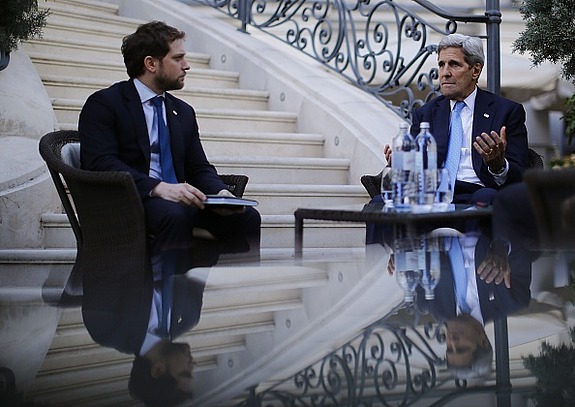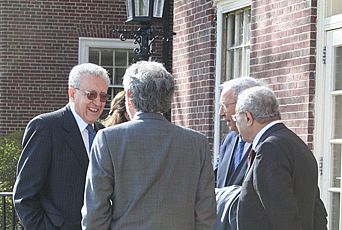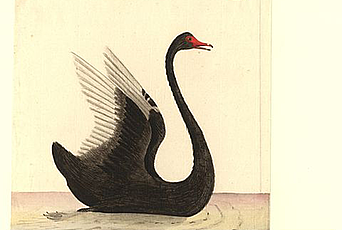Examining Contemporary Foreign Policy and the Role of Historical Analogy

Just before Thanksgiving last year, I sent an email to the Institute’s Director, Robbert Dijkgraaf, whom I had never met. Acknowledging that my missive was somewhat “out of the blue,” I explained that I had spent most of the previous eight years working on foreign policy in President Barack Obama’s White House and State Department, and that I was looking for a place to do some research and writing as I transitioned to the next phase of my career. Unexpectedly, and to my eternal gratitude, I received a response a bit more than a week later asking if I might be interested in serving as Director’s Visitor at the Institute, starting in the spring. I enthusiastically accepted.
I was drawn to the Institute for a number of reasons. Having worked closely with outstanding scientists during my time in government—nuclear physicists, on the Iran nuclear talks, and climate scientists, on the Paris climate negotiations—I came to appreciate how essential such expertise and perspectives are to policymaking. And I looked forward to benefitting from the crosspollination that can only occur when different disciplines coexist.
I also had two more personal reasons for wanting to spend time at the Institute. The first is that my uncle, Franklin Toker, a professor of art and architectural history at the University of Pittsburgh, had been a Member in the 1980s, and he and his family had always raved about the experience. The second is that the Institute was the academic home of the late George Kennan, a foreign policy luminary who in the 1940s had established and served as director of the State Department’s Office of Policy Planning, a position I held at the end of the Obama Administration.
Since March, while also teaching at Princeton’s Woodrow Wilson School of Public and International Affairs, I have been fortunate to spend time at the Institute researching and reflecting on two related topics, one contemporary and one historical: the new U.S. Administration’s unorthodox approach to foreign policy and the role of history in the making of foreign policy.
The first topic ended up occupying more of my time here than I expected, in large part due to the many and complex ways in which the Trump Administration’s approach to issues such as the role of the United States in the world and the process for making national security decisions has been such a break from that of past administrations of both parties.
I was drawn to the Institute for a number of reasons. Having worked closely with outstanding scientists during my time in government—nuclear physicists, on the Iran nuclear talks, and climate scientists, on the Paris climate negotiations—I came to appreciate how essential such expertise and perspectives are to policymaking.
Since arriving in Princeton, I have written and commented frequently on such subjects as the primacy (or diminishment) of diplomacy among the foreign policy tools at the Administration’s disposal, the strategy (or lack thereof ) being employed by the new Administration, and the most important areas of change (and, less often noted, continuity), between the new Administration and its predecessors. I gave a lunchtime talk on these topics at the Institute on May 31, in which I laid out the Administration’s disruptive approach to the key determinants of policy: personnel, process, public posture, and principles.
The second topic I focused on while at the Institute is how policymakers use—and often misuse—so-called “lessons of history” or historical analogies. I have been interested in this topic since I was a graduate student, working with a scholar named Yuen Foong Khong, whose insightful book Analogies at War explores how history had influenced decisions made in the context of the Vietnam War. The seminal works in this subfield of international relations were produced in the 1970s and 1980s by Harvard’s Ernest May (“Lessons” of the Past and Thinking in Time, which he wrote with Richard E. Neustadt). The thrust of these works is that, for policymakers faced with difficult decisions, history is seductive, essential, and frequently abused.
Drawing on the theoretical approaches in this literature, I spent time examining an area of our foreign policy that I’ve come to believe has replaced World War Two and Vietnam as the dominant lens through which decision-makers understand America’s place in the world and the extent and limits of our power: Iraq, where the United States has been at war, more or less uninterrupted, for more than twenty-five years.
The beginning of this unlikely shift toward an Iraq-centric foreign policy is debatable. The United States first became engaged militarily in this region during the 1980s Iran–Iraq War, but the clearest starting point is the 1991 Persian Gulf War, which came just as the Cold War was ending and the United States, which for decades had defined its foreign policy in opposition to Soviet communism, was charting a new role in the so-called “new world order.” After Saddam Hussein invaded Kuwait, President George H. W. Bush built a global coalition that cemented the United States’ status as the lone superpower.
Bill Clinton then took office at the apex of American global power and quietly continued the conflict in Iraq throughout his presidency, an experience in low-cost, limited war that ultimately helped open his mind to intervening militarily in the Balkans. He shifted America’s Iraq policy to regime change; developed a new foreign policy tool—crippling economic sanctions; and famously described America as the “indispensable nation” to justify further escalating the Iraq conflict at the end of his term.
George W. Bush elevated Iraq from prominent to preeminent among America’s priorities by ordering, under a deeply dubious justification, the fateful U.S. invasion in 2003—an audacious, ambitious, and ultimately disastrous bet that America could forcefully refashion the world’s most autocratic region in our democratic image. The chaos that Bush’s “war of choice” wrought, as the United States fatally bungled the aftermath, unleashed the twin forces that continue to ravage the Middle East to this day: sectarian hatred and jihadi extremism.
When Barack Obama, for whom opposition to the Iraq War was essential to his rise, became president by defeating two more experienced adversaries who were also Iraq War proponents, the lessons of Iraq seemed clear—prioritize diplomacy, be willing to engage difficult adversaries, resist military entanglements in the Middle East. These lessons played an outsize role in Obama’s diplomacy and decision- making on Iran and Syria (the subject of my course at the Woodrow Wilson School). On Iran, they helped bring about a nuclear agreement that, while controversial, is widely considered among the most important diplomatic breakthroughs in a generation. On Syria, while the lessons of Iraq arguably helped Obama avoid even worse outcomes, the result has been disastrous for the Syrian people, the region, and beyond.
The Trump Administration has drawn some similar and some entirely different conclusions from the U.S. experience in Iraq. Like President Obama, President Trump has said he believes the invasion of Iraq was a mistake (though Trump said otherwise at the time) and that he therefore believes the United States should avoid “quagmires.”
However, Trump has also increased U.S. military involvement in Somalia, Yemen, Syria, Iraq, and Afghanistan. And his team also clearly believes Obama was far too focused on engagement with Iran, and too unwilling to confront a country responsible for more than one thousand American deaths in Iraq. He has severed diplomatic channels to Iran and accused it of violating the spirit of the nuclear agreement (which he calls “the worst deal in history”) by supporting terrorists and testing long-range missiles—even though those activities are not proscribed by the deal, the Administration has formally certified Iran’s compliance with it.
All of this bears continual observation and analysis going forward. At a time when our basic understandings about the world, objective facts, and academic rigor are under assault, it was gratifying to spend time at an Institute that stands for, and lives by, these essential principles. For these and many other reasons, the Institute’s work has, perhaps, never been more important, and I am grateful to have had the opportunity to be a part of this extraordinary community.


